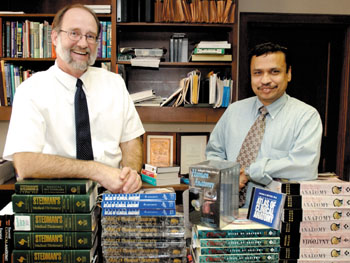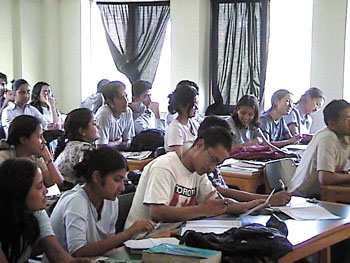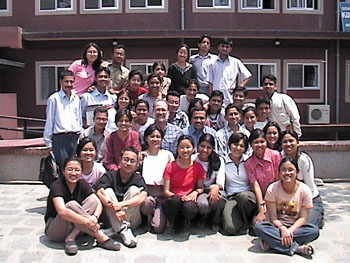
Art Dalley, Ph.D., left, and Shiva Gautam, Ph.D., are donating their time, talent and resources to help make Kathmandu Medical University a place to adequately train students in Nepal. (photo by Dana Johnson)
Going to Kathmandu

Students work in close quarters at the school. (photo by Art Dalley)

There are currently 44 students enrolled in the Kathmandu University Medical School. Next year, 60 students are expected to enroll. (photo by Art Dalley)
Shiva Gautam, Ph.D., assistant professor of Preventive Medicine, has a goal: cultivate Kathmandu University Medical School into a quality medical institution in his native land of Nepal.
Colleague Art Dalley, Ph.D., professor of Cell Biology, is helping Gautam achieve his goal. For Gautam and Dalley, it is not only a goal, it is a labor of love. The two have just returned from a month in Nepal where they evaluated the students’ progress and took an inventory of the supplies and resources needed by the school.
Although Nepal has two government medical colleges and several other for-profit medical training institutions, the schools are not highly regarded outside of Nepal. Kathmandu University, located in the nation’s capitol, is a private, non-profit school that is considered the highest quality institution of higher learning in the country. The new medical school is affiliated with the university.
Situated in the heights of the Himalayan Mountains, Nepal is a land of spectacular scenery and aged temples, rich in culture and scenic grandeur. However, the nation itself is poor. As an agrarian country, farming is the primary economic activity. Education is not a priority. The caste system continues to function, creating a divide along social, ethnic, economic, and gender lines.
The Kathmandu University Medical School hopes to change that.
Through the vision of volunteers such as Gautam and Dalley, the new medical school was conceived. Due to the lack of medical professionals and senior faculty, one of the primary goals of the institution will be self-sufficiency. Students will be trained to not only practice medicine in their communities, but to return to the school to teach future physicians as well.
For Gautam, who is also a published Nepalese poet, his interest in this program was based on the school’s mission to fill a need in his native land.
“I was compelled to become involved because this will be the first time that any medical school in Nepal is trying to address local health issues,” explained Gautam. “This is the first school to encourage an increase in the population of female students. They are also devoting 20 percent of their curriculum to community medicine.”
Dalley added, “The goal is to train physicians to go back into Nepal and practice community medicine and practice primary care medicine.”
For this reason, the curriculum will be structured differently. Due to the lack of medical technology, such as MRI or CT scanning, more emphasis will be placed on making more hands-on diagnoses. In Nepal, medicine will be delivered at the grassroots level.
To be built on land donated by the government, the fledgling medical school began its first semester in August 2001 in a rented space from a local hospital. A total of 44 students are enrolled in the first class — 55 percent of the students are female. Students enter the six-year medical school program following high school, focusing on basic science during the first year. Sixty students are expected to enroll in the next class.
With a shortage of experienced senior medical faculty in Nepal, graduate students and post-doctoral students from U.S. universities do much of the teaching.
Due to requirements of the Nepal Medical Council, retired medical school faculty from India oversee many of the classes.
As unconventional as this approach may be to westerners, it is working in Nepal — for now. As the students in their first year matriculate, the complexity of their course work will increase. Experienced faculty will be required to educate the students and prepare them for a life of diagnosing and treating patients.
Gautam is the only biostatistician in Nepal with his level of experience. Many specialty areas are not represented. The lack of adequate teaching resources means that Dalley and Gautam will be recruiting other faculty, from Vanderbilt and elsewhere, to donate their time to teaching the Nepali students.
While in Nepal, Gautam and Dalley saw the need for medical supplies and other resources. Prior to their trip, the two procured valuable teaching tools. Dalley, a writer and editor of anatomy textbooks, wrote to his publishers, sharing his vision of the school and its lack of adequate teaching materials. The result was thousands of dollars worth of anatomy textbooks and interactive CD ROMs. The American Nepal Medical Foundation (ANMF), a consortium of Nepali physicians practicing in the United States, U.S. physicians who have worked in Nepal, and people involved and interested in medical and health issues, paid to have the materials shipped to Nepal.
Dr. Kay Washington, associate professor of Pathology, donated three microscopes, two of them double-headed. More supplies are still needed.
A permanent building to house the school would also be helpful. Currently the students have use of a local hospital, although Dalley and Gautam hope to see a university hospital built to fully accommodate the clinical training of the students.
For the students, there is the hope that they can make a difference in their country, a belief that through their education and practice, they will be able to provide needed medical care and treatment to people in their communities.
For the faculty and Gautam and Dalley, the dedication and eagerness of the students is inspiring.
“The way it’s happening is a miracle,” said Gautam. “But, there are still many miracles that need to happen.”
Gautam and Dalley plan to continue their involvement with the school in Kathmandu and its students. A large part of their efforts will center around lobbying universities to become involved in the program and petitioning medical schools and hospitals to donate equipment and other teaching materials. They will also encourage U.S. medical students to spend time assisting faculty as teaching assistants. Not only will medical students be able to offer help to the overworked faculty, but, Dalley feels, they will learn more about themselves and the value of the education afforded to them by their medical school in the United States.
“Students will have a life-changing event if they offer their services,” Dalley said. “Involvement on any level, donations of any amount, may mean many life-changing events for the students of the Kathmandu Medical School, the many Nepali people who they will treat throughout their careers, and the future students whom they will teach.”
Persons interested in volunteering their time or donating equipment should contact Gautam at 343-5437 (shiva.gautam@mcmail.vanderbilt.edu) or Dalley at 322-6572 (art.dalley@vanderbilt.edu).













